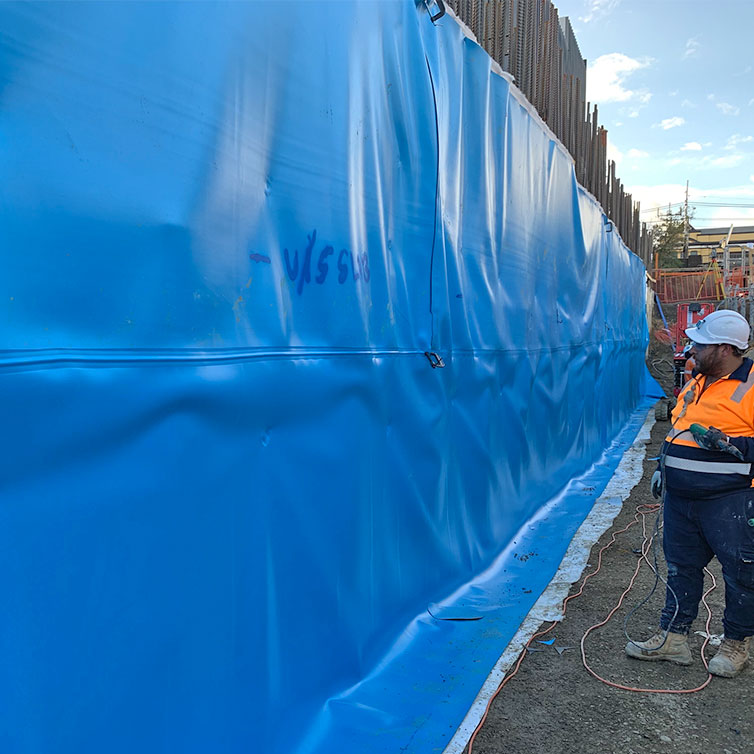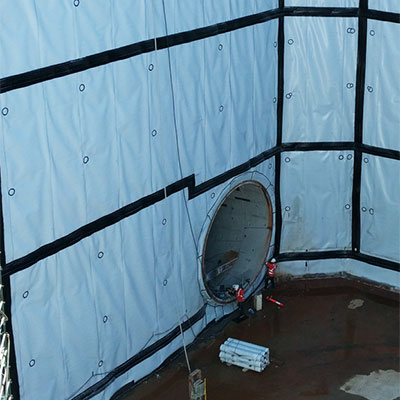When waterproofing underground, the effort required to resist water pressure is often underestimated, so we’ve put together a list to solve the most common issues faced by waterproofing installers.
1 Selecting the right membrane type and thickness
Bluey looks to International Standards, as well as our decades of experience in this area, to help you make the right decision. Not all membranes will work in all situations. Bluey offers a PVC as well as a VLDPE liner, to accommodate different pressures and conditions.
2 Consider the ground squeeze
It’s important to select the right type of membrane-based upon the expected ‘ground-squeeze’ after concrete placement. Bluey has completed testing on all our membrane systems so that we can provide engineering advice on the right type of membrane that will cope with the conditions.
3 Use engineered compression gaskets to terminate cross-passage TBMs
Terminating cross-passage membranes to TBM segments had previously been one of the unsolved mysteries of the tunnelling world. The Bluey solution of engineered compression gaskets is now being adopted around the world and is leading the way in successfully solving this problem.
4 Apply fixings with no maximum load
Once the membrane is installed, there is almost always a requirement to apply fixings through the membrane. These could be required for reinforcement cages, formwork systems or services. Fixings must be used which seal to the membrane, no matter how high the load.
5 All uplift piles must be sealed
Simply terminating membrane to the pile perimeter is not enough, as water will continue to rise through cracks in the top of the piles and through the voids around the reinforcement. Bluey has developed a unique capping system which will seal up to 100 m of water head at a pile location.
6 When terminating to diaphragm walls, use suitable pressure termination.
Terminating the waterproofing membrane to diaphragm walls and sheet piles can’t be completed by simply applying ‘glue’ or liquid membrane. This high-pressure area is a common point of leakage if it is not sealed using an engineered gasket or suitable pressure termination.
7 Relieve groundwater pressure
Groundwater pressure often needs to be relieved from behind the installed membrane, prior to and during concrete casting. If this is not done successfully, then the membrane can tear during the final stages of pouring.
8 Ensure there’s enough slack to cover the entire perimeter of the roundel
The membrane needs to be adequately ‘quilted’ during installation. If not, it will go into tension during pouring and tear at the seams. Alternatively, too much slack will create folds and potential breakage points.
9 Fix the membrane to the tunnel surface using a plastic roundel.
Did you know that the weld to the roundel is designed to break under load before it tears the membrane? If the membrane does go into tension during the concrete pour, a properly welded roundel will not damage the membrane.
10 Fill all voids after grouting
After concrete casting, there are almost certainly going to be voids remaining in the crown or high points. It is critical that these points are filled with second stage grouting systems through pre-installed grout ports at allocated locations. Bluey designs these systems for our partners.
Determining the membrane type and thickness is an important few steps in any underground waterproofing project. Getting it right the first time can save you money and reduce potentially expensive rectification works. The team at Bluey applies decades of experience in this area, to support you in making the right decision.
Want to learn more?
- Download the Brochure
- VLDPE Tunnel Liner: https://www.bluey.com.au/products/bluseal-vldpe-tunnel-liner
- PVC Tunnel Liner: https://www.bluey.com.au/products/bluseal-pvc-tunnel-liner
- Other tunnel liner applications: https://www.bluey.com.au/project/bluseal-tunnel-liner-systems
Contact us at 1300 0 BLUEY


